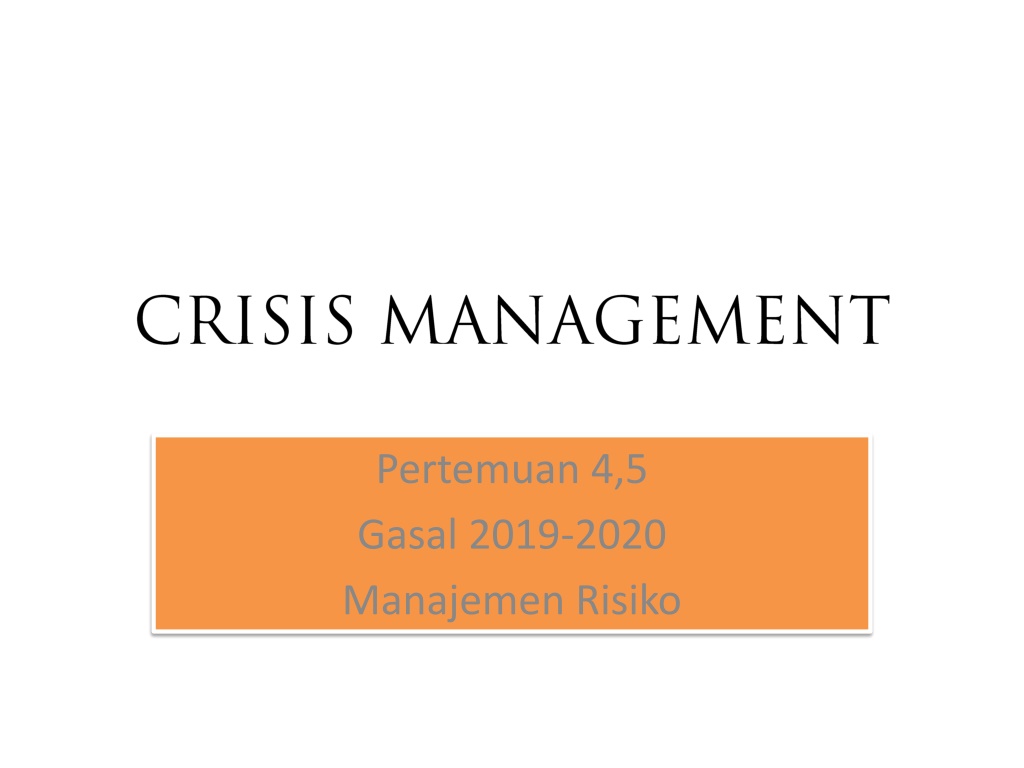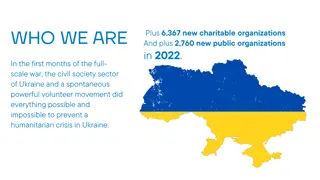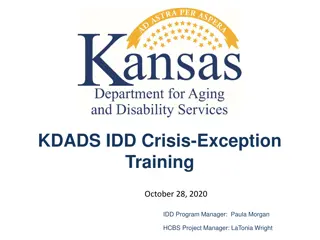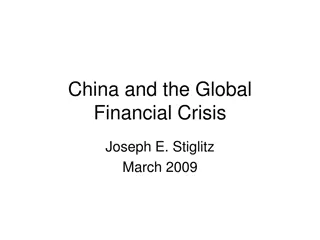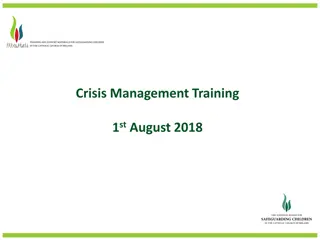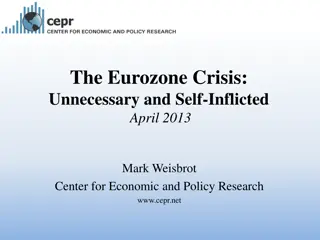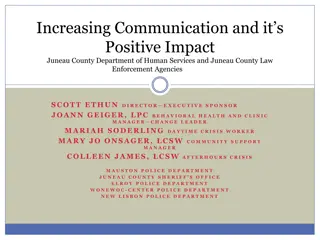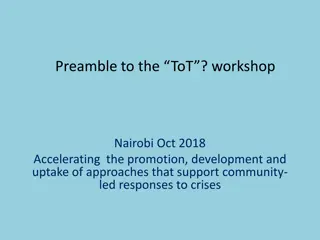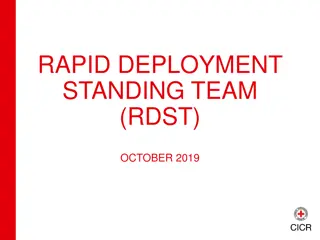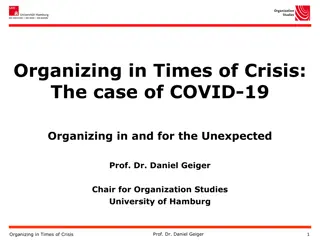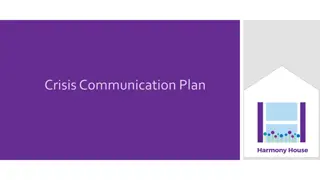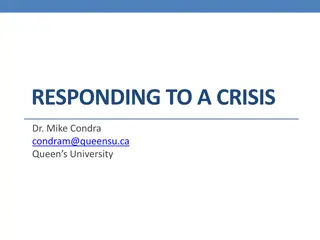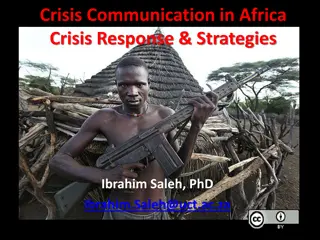Crisis Management in Organizational Context: Understanding, Planning, and Response
Crisis management is essential for organizations to navigate unexpected and high-risk situations effectively. A crisis is a time of intense difficulty or danger that requires strategic decision-making and communication under pressure. The phases of crisis management include pre-crisis prevention, preparation, crisis response, and post-crisis evaluation. Organizations can better handle crises by having a regularly updated crisis management plan, a designated crisis management team, conducting exercises to test plans and teams, and pre-drafting crisis messages.
Download Presentation

Please find below an Image/Link to download the presentation.
The content on the website is provided AS IS for your information and personal use only. It may not be sold, licensed, or shared on other websites without obtaining consent from the author. Download presentation by click this link. If you encounter any issues during the download, it is possible that the publisher has removed the file from their server.
E N D
Presentation Transcript
Pertemuan 4,5 Gasal 2019-2020 Manajemen Risiko
DEFINITION OF CRISIS Definition Keywords A crisis is a situation faced by an individual, group or organization which they are unable to cope with by the use of normal routine procedures and in which stress is created by sudden change. Situation, procedures, sudden change Crisis is a time of intense difficulty, trouble or danger and can be personal, or confined to a small population, like a family, or a company dealing with a very serious problem. (Lighthouse Readiness Group). Trouble, danger, serious problem In an organisational context, crises are usually new situations to the organisation, often defined as unexpected, definetely unstructured and outside the typical operational framework of the organization (Beall, 2007). Undexpected. unstructuctured
CRISIS MANAGEMENT Crisis management is making, implementing and communicating strategic decisions under exceptional circumtances of intense scrutiny, acute pressure and high organizational risk Andrew Griffin. Manajemen krisis adalah membuat, menerapkan dan mengomunikasikan keputusan strategis pada situasi genting yang diawasi secara ketat, tekanan akut dan risiko organisasi tinggi
CRISIS PHASE Crisis management can be divided into three phases: 1. Pre-crisis 2. Crisis response 3. Post-crisis
Post- Crisis Pre-Crisis
PRE-CRISIS PHASE Prevention involves seeking to reduce known risks that could lead to a crisis. This is part of an organization s risk management program. Preparation involves creating the crisis management plan, selecting and training the crisis management team, and conducting exercises to test the crisis management plan and crisis management team.
THE PURPOSE Organizations are better able to handle crises when they: Have a crisis management plan that is updated regularly; Have a designated crisis management team; Conduct exercises to test the plans and teams regularly; Have a Pre-draft some crisis messages The planning and preparation allow crisis teams to react faster and to make more effective decisions.
CRISIS MANAGEMENT PLAN A crisis management plan (CMP) is a reference tool, not a blueprint. A CMP provides lists of key contact information, reminders of what should be done in a crisis, and forms to be used to document the crisis response. a CMP saves time during a crisis by pre-assigning some tasks, pre-collecting some information, and serving as a reference source. The team members should know what tasks and responsibilities they have during a crisis. (Barton 2001, Coombs 2007a, and Fearn-Banks 2001)
CRISIS MANAGEMENT TEAM Barton (2001) identifies the common members of the crisis team as public relations, legal, security, operations, finance, and human resources. However, the composition will vary based on the nature of the crisis.
Develop holding statements Anticipate crisis Identify & know stakeholders Identified crisis comm team Establish Notification & Monitoring Systems Identify & train spokepersons Spokesperso n training
Crisis Types Natural disasters: acts of nature such as tornadoes or earthquakes. Rumors: false and damaging information being circulated about you organization. Workplace violence: attack by former or current employee on current employees on- site. Product Tampering/Malevolence: external agent causes damage to the organization. Challenges: stakeholder claim that the organization is operating in an inappropriate manner. Technical error accidents: equipment or technology failure that cause an industrial accident. Technical error product harm: equipment or technology failure that cause a product to be defective or potentially harmful. Human-error accidents: industrial accident caused by human error. Human-error product harm: product is defective or potentially harmful because of human error. Organizational misdeed: management actions that put stakeholders at risk and/or violate the law.
Spoke persons: Right skills Matching potential spokespersons skills with their assignments as a member of the Crisis Communications Team is critical. Spokespersons needed for for all types and forms of communications, internal and external. Spokepersons must be able of speaking on- camera, at a public meeting, at employee meetings, etc. Fact: Social media is a very easy place to make a mistake.
Right Persons The decision about who should speak is made after a crisis breaks but the potential spokespersons should be identified and trained in advance. Don t wait under fire. situation. Fact: some chief executives are great organizational leaders but not so effective in- person communicators.
SPOKEPERSONS TRAINING A key component of crisis team training is spokesperson training. Organizational members must be prepared to talk to the news media during a crisis. (Lerbinger 1997), Feran-Banks 2001, and Coombs 2007a)
Right Training How to speak to the media Proactive PR= focuses on promoting organization; crisis communications= focuses on preserving organization No comment = We are guilty; we are hiding something The ability to make a flawless personal presentation to 1,000 people at a conference does not, without training, automatically translate to an ability to conduct an on-camera media interview related to a crisis.
Holding Statements We have implemented our crisis response plan, which places the highest priority on the health and safety of our guests and staff. Our thoughts are with those who were in harm s way, and we hope that they are well. We will be supplying additional information when it is available and posting it on our website.
Establish Notification It is absolutely essential, pre-crisis, to establish notification systems that will allow you to rapidly reach your stakeholders using multiple modalities. Eg: Phone, email, messanger, social media. If you use more than one modality to reach your stakeholders, the chances are much greater that the message will go through.
Monitoring System Knowing what s being said about you on social media, in traditional media, by your employees, customers, and other stakeholders often allows you to catch a negative trend that, if unchecked, turns into a crisis. Likewise, monitoring feedback from all stakeholders during a crisis situation allows you to accurately adapt your strategy and tactics. Both require monitoring systems be established in advance. For traditional and social media, Google Alerts are the no-cost favorite, but there are also free social media tracking apps such as Hootsuite.
POST-CRISIS ANALYSIS The question must be asked, What did we learn from this? A formal analysis of what was done right, what was done wrong, what could be done better next time and how to improve various elements of crisis preparedness is another must-do activity for any Crisis Communications Team.
CONCERN The pre-crisis phase is concerned with prevention and preparation. The crisis response phase is when management must actually respond to a crisis. The post-crisis phase looks for ways to better prepare for the next crisis and fulfills commitments made during the crisis phase including follow-up information.
1 Leads to Unresolved Internal Issue Internal Incident
Contoh kasus: Perusahaan penerbangan Terbang BebasAirways memiliki beberapa pesawat yang sudah berumur. Tapi karena pertimbangan efisiensi, perusahaan tidak menggantinya dengan pesawat2 baru. Lalu terjadi kecelakaan karena kerusakan mesin. Perusahaan menyadari ada potensi risiko tapi mengabaikannya.
2 Creates Longer- Term Internal Issue Internal Incident
Ada kejadian, atau serangkaian kejadian, meskipun kecil tapi berulang-ulang sehingga membentuk persepsi tertentu terhadap perusahaan. Contohnya: Perusahaan X gagal menyelesaikan order sesuai tenggat waktu, karena alasan tertentu. Lalu kejadian tersebut terulang sehingga akhirnya perusahaan diingat sebagai perusahaan yang tidak komit dalam hal deadline.
3 Triggers Internal Incident ExternaI Issue
Krisis yang terjadi dalam internal perusahaan menjadi isu sosial politik yang harus direspons oleh industri. Contohnya, suatu RS mengalami masalah dengan pasien terkait pelayanan. Sehingga memicu munculnya isu pelayanan bidang kesehatan pada umumnya.
4 becomes Internal Issue ExternaI Issue
Isu internal bisa berkembang menjadi isu eksternal dan memengaruhi industri keseluruhan. Contoh ketika sebuah perusahaan surat kabar menghadapi isu soal performa keuangan yang terus menurun kemudian berkembang menjadi isu bahwa industri media cetak akan tenggelam tergantikan digital, misalnya.
5 Triggers External Incident ExternaI Issue
Insiden Eksternal memicu isu eksternal. Misalnya terjadi kecelakaan mobil di jalan tol, bisa memicu isu keselamatan berkendara di jalan tol. Perusahaan perlu merespons isu tersebut dengan melahirkan teknologi yang terbukti aman untuk berkendara di jalan tol.
6 Leads to Unresolved External Issue ExternaI Incident
Isu eksternal yang tidak tuntas penyelesaiannya bisa mengarah pada insiden eksternal. Contohnya: Isu mengenai kesejahteraan buruh selalu berpotensi memicu demo buruh setiap peringatan hari buruh.
7 Triggers External Incident Internal Issue
Insiden eksternal menjadi isu internal. Contohnya: terjadinya peristiwa pasien yang meninggal karena salah penanganan di rumah sakit bisa menjadi isu internal di perusahaan obat untuk memastikan keamanan produknya.
8 Amplifies External Issue Internal Issue
Isu eksternal memperkuat (menggaungkan) isu internal. Misal: Industri perbankan saat ini sedang jadi sorotan. Orang banyak meninggalkan perbankan konvensional. Sehingga isu sekecil apapun yang terjadi di dalam internal suatu bank, bisa memancing reaksi publik.
